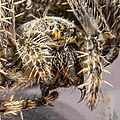Araneus diadematus
Araneus diadematus
Araneus diadematus, commonly known as the European garden spider, cross orb-weaver, or diadem spider, is a species of orb-weaver spider found across Europe and North America. It is one of the most common and recognizable spiders in these regions due to its distinctive cross-like markings on the abdomen.
Description
Araneus diadematus exhibits sexual dimorphism, with females being significantly larger than males. Females typically measure between 6.5 to 20 mm in body length, while males are smaller, ranging from 5.5 to 13 mm. The coloration of these spiders can vary from light yellow to dark grey, but they are most commonly brown with a characteristic white cross on the dorsal side of the abdomen, formed by a series of white spots.
Habitat
This species is commonly found in gardens, woodlands, and hedgerows. Araneus diadematus constructs large, wheel-shaped webs, which are often found in open spaces between trees and shrubs. These webs are used to capture prey, primarily flying insects such as flies, mosquitoes, and moths.
Behavior
Araneus diadematus is primarily active during the late summer and autumn months. The spider is known for its web-building skills, creating intricate orb webs that can be up to 40 cm in diameter. The spider typically sits in the center of the web, waiting for prey to become ensnared. Once an insect is caught, the spider quickly immobilizes it with silk before consuming it.
Life Cycle
The life cycle of Araneus diadematus begins with the laying of eggs in the autumn. The female produces an egg sac, which she attaches to a secure location. The eggs hatch in the spring, and the young spiderlings disperse by ballooning, a process where they release silk threads to catch the wind and travel to new locations. The spiders mature over the summer and reach adulthood by late summer or early autumn.
Predators and Defense
Araneus diadematus has several natural predators, including birds, wasps, and other larger spiders. To defend against these threats, the spider may drop from its web and hide in nearby foliage. The coloration of the spider also provides camouflage against predators.
Related pages
Transform your life with W8MD's budget GLP-1 injections from $125.
W8MD offers a medical weight loss program to lose weight in Philadelphia. Our physician-supervised medical weight loss provides:
- Most insurances accepted or discounted self-pay rates. We will obtain insurance prior authorizations if needed.
- Generic GLP1 weight loss injections from $125 for the starting dose.
- Also offer prescription weight loss medications including Phentermine, Qsymia, Diethylpropion, Contrave etc.
NYC weight loss doctor appointments
Start your NYC weight loss journey today at our NYC medical weight loss and Philadelphia medical weight loss clinics.
- Call 718-946-5500 to lose weight in NYC or for medical weight loss in Philadelphia 215-676-2334.
- Tags:NYC medical weight loss, Philadelphia lose weight Zepbound NYC, Budget GLP1 weight loss injections, Wegovy Philadelphia, Wegovy NYC, Philadelphia medical weight loss, Brookly weight loss and Wegovy NYC
|
WikiMD's Wellness Encyclopedia |
| Let Food Be Thy Medicine Medicine Thy Food - Hippocrates |
Medical Disclaimer: WikiMD is not a substitute for professional medical advice. The information on WikiMD is provided as an information resource only, may be incorrect, outdated or misleading, and is not to be used or relied on for any diagnostic or treatment purposes. Please consult your health care provider before making any healthcare decisions or for guidance about a specific medical condition. WikiMD expressly disclaims responsibility, and shall have no liability, for any damages, loss, injury, or liability whatsoever suffered as a result of your reliance on the information contained in this site. By visiting this site you agree to the foregoing terms and conditions, which may from time to time be changed or supplemented by WikiMD. If you do not agree to the foregoing terms and conditions, you should not enter or use this site. See full disclaimer.
Credits:Most images are courtesy of Wikimedia commons, and templates, categories Wikipedia, licensed under CC BY SA or similar.
Contributors: Prab R. Tumpati, MD












